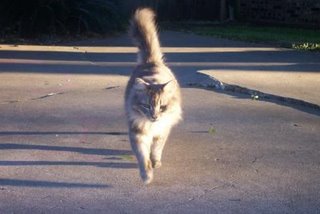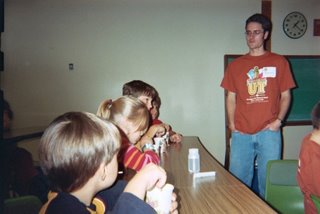(I found this in my draft folder)
I was rambling earlier:
My philosophy of education has changed since I first started teaching my own children. I started out teaching the way that I had been taught and our style here at home was very much like a public school. Playing school was very comfortable to me and I've had plenty of practice. I went to public school for 13 years of my life and was raised by two public school teachers. I would often help my mom grade tests. Not only that, but I used to line up my plush animals and teach to them, create tests for them, and then take those tests for them so that I could grade them. Yes, I even kept report cards for each of my plush students and sent them to the principal's office when they misbehaved. Guess who their principal was. You got it. I find myself constantly rediscovering our family learning style and reevaluating my philosophy of education. The definitions of the words "learn" and "teach" have dramatically changed over the years, for me, and I can see a difference between "education" and "schooling."
I decided to homeschool my child while obtaining my degree in education. I didn't have anything against public schools, I wanted to be a teacher, and my parents were teachers, but I really wanted to teach my child myself. I was really excited about the concept of home-education. I had all these wonderful fantasies playing out in my mind of me, the teacher/mom, teaching to my very interested and attentive student/child.
HA! (Shouted like the 'basket case' when she interrupts Molly Ringwald's pity party in THE BREAKFAST CLUB)
When I first started homeschooling my now 13 year old, we ordered the K5 Abeka, but he was already reading when it came in the mail, UPS was on strike that year. Needless to say, much of my purchase was a waste of money! We had been playing around with refrigerator magnets and reading many books together. I think that THAT interaction or life-style was enough to make him a reader.
He quickly learned Math in pretty much the same way. He could count, so with a Math Blaster computer game and an abacus, he learned quickly how to solve basic math problems so that he could save the world. (He had to work about 10 Math problems before he was allowed to fire at invaders..) He learned basic math skills so that he could save the world. What motivation! His kindergarten Math book was completed before Christmas, "for the fun of it."
I liked Abeka because it was what my brothers and my sister were using at their private school and I was very comfortable with it. I had helped them study for tests by quizzing them. I guess I tried really hard to play classroom here in my home but it just wasn't working out that way! I lacked the 20 other students to help encourage my son to sit still? That was hard for me!
I can remember reading out loud to my son as his body would move very much like the minute hand of a clock: his head would start out pointing to the 12:00 position, like in my fantasies, but would end up at 6:00, 9:00, and 3:00.. feet in the air. He always knew what I had just read, but his body couldn't be still! In fact, if I forced him to be still, he couldn't comprehend what I read because he was focusing so hard on trying to be still! It took some rethinking of what "learning" meant to allow me to accept my son's hyper-learning style. It wasn't a discipline problem, but how he learned. One of the reasons I decided to homeschool him was because he was very advanced but not when still. Can you imagine how that would have translated to a classroom setting?
He seemed to be learning in non-conventional ways. He learned better when he played educational games or read what he wanted to read or researched what he wanted to research. He was so far ahead that we didn't use curriculum for a few years - just let him collect and label bugs or focus on whatever other hobby he wanted to dive into. He had the audacity to continue to learn without school or without the aid of ‘schooly’ things! I experienced what Mark Twain meant when he said, "I never let schooling get in the way of my education." I don't know if I would have ever understood that quote before I saw it lived out in front of me.
For third grade, we tried to use Abeka again and we lasted a whole year! We did the tests and kept report cards! (Though that's not required in
The next year I decided to start out by quizzing him with some old tests that he had previously aced. I was shocked and appalled that he couldn't remember most of the answers! The facts and details of what he had learned for the tests the year before didn't seem to make their way to the long term memory or to survive the summer! Had we wasted a whole year? That's when I realized that I probably didn't remember the answers to many of the tests that I had passed either! He could still read, thank God. I guess learning to read is like learning to ride a bicycle, without the skinned knees.
I decided that "tests" and "grades" would not be our educational goal, but rather skills that he could use for the rest of his life. For example: What if we focus on finding the answers and asking the questions instead of memorizing the answers? What if we made research a major part of how we learn here in our home? This skill can come in handy when he is in college and expected to write a research paper or thesis. My favorite quote is by Roger Lewin, "Too often we give children answers to remember rather than problems to solve." While looking into Classical Education I ran into another quote that I really love. It is by Dorothy Sayers: "Is not the great defect of our education today...that although we often succeed in teaching our pupils subjects, we fail lamentably on the whole in teaching them how to think: they learn everything, except the art of learning." If I remember correctly, she was referring to the Nazi educational system. They had taught much about what to think, but no one seemed to be able to think for themselves or to think. She warned that when people are not able to think for themselves they will easily be controlled by a tyrant.
Instead of doing a traditional study or course called "English" what if we learned all we could about our language by learning where each word originated and what the history behind how the word came to mean what it means today? What if we focused on our language and its rules in action and in context by reading often, aloud to each other and silently to ourselves? We could learn the rules of our language from a deductive approach instead of an inductive approach. (I asked ZOLAonAOL to define 'inductive' for me and she said, "The act of eating waterfowl" so I am not sure if I am using 'inductive' and 'deductive' right.)
Focusing on a Greek or Latin root a week gave us a small history lesson, as the root usually had a story behind it. Focusing on roots also introduced us to a list of new words (spelling) and helped with our vocabulary! I made it my goal to find other ways to combine several subjects into one - to free up time for more important things like playing or traveling or visiting friends.
Each time we read a book together something mentioned in the book sparked an interest or curiosity about some other topic. When we read "Charlie and the Great Glass Elevator" we became interested in researching and learning more about orbits, satellites, and eventually the solar system. I guess we allowed literature to provide us with ideas on what we could research and learn more about. The children's curiosities provide the energy, but following those curiosities is a bit like trying to steer a sailboat without a rudder: we are moving, forward maybe, but I don't know what our destination is or when we will 'arrive.' There is always more to learn about any topic or subject!
I pray for God to be our curriculum guide and to bring educational opportunities into our lives and to help me be able to recognize and take hold of 'teachable moments' in our every day lives. When I start out our day with that prayer and mindset the random dots that pop up throughout the day seem to become connected and to form a more tangible picture of where we are going.
(WOW, I need to take my own advice!)
Rebecca
"Let the questions be the curriculum" Socrates




